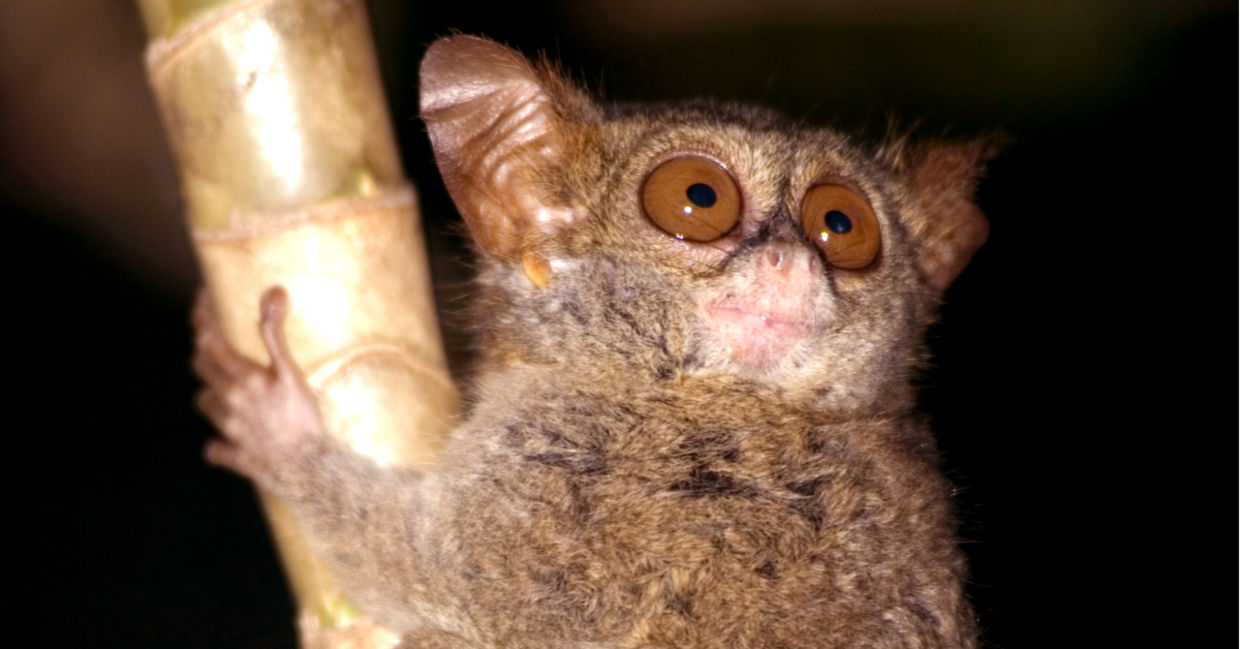
(mosista / Shutterstock.com)
Every once in a while, an animal that scientists thought was lost for good and therefore extinct, is miraculously rediscovered. The name that researchers themselves have given these lost-and-found marvels is “Lazarus species”, as they seem to be resurrected, just like Lazarus in the Bible.
Significant environmental challenges to animal species including habitat loss and climate change, mean that more animals have been put at risk. So we’ve become used to hearing about species that scientists are convinced don’t exist anymore, with no sightings made of them for years.
But the good news is the small but growing list of resilient comeback species. Let’s meet seven of them!
Pygmy tarsier
Cute and tiny two-ounce pygmy tarsiers, formally presumed extinct, were found again during a 2008 expedition to Indonesia. These saucer-eyed nocturnal primates are often compared to Furby toys, Yoda from Star Wars, and the stars of Gremlins.
Tarsiers are the only completely carnivorous primates. Mostly, they eat insects and arthropods. Scientists believe that the pygmy tarsier’s small size may be an adaptation to its damp montane environment, which lacks a wide variety of food sources. More: https://t.co/sv3IyreyzM pic.twitter.com/wAS7UZ9KvD
— NEPrimateConservancy (@NEPrimateConsrv) February 4, 2021
Sharon Gursky-Doyen, the physical anthropologist from Texas A&M University who observed live Pygmy tarsiers high in the mountains of Sulawesi, believes it’s the “perpetual smile” on their faces that makes them so endearing.
Voeltzkow’s chameleon
An expedition team made up of scientists from universities in Munich, Germany and the local University of Antananarivo in Madagascar, found this elusive chameleon in late 2020 — some 100 years after it was last spotted. It is believed that this species only lives during the rainy season, with a short lifecycle that’s just a few months long.
What was news to the team, was that the females of the species, are brilliantly colorful, able to change their color according to mood between spectacular hues of purple, orange, red, green, black and white—with striking patterns.
Found: The Voeltzkow’s Chameleon was believed to have been lost to science since 1913. An expedition team rediscovered the colorful species on an expedition in #Madagascar. This is the 6th of @global_wildlife’s most wanted lost species that has been found.
— Leonardo DiCaprio (@LeoDiCaprio) November 19, 2020
Video: Frank Glaw pic.twitter.com/r6SAPjc5vW
“The Voeltzkow’s chameleon adds color and beauty to the planet, and reminds us that even when all seems lost, a great adventure can rekindle hope even for species we haven’t seen since Woodrow Wilson was president,” said Don Church, Global Wildlife Conservation’s president “Now we have so much to learn about this extraordinary reptile, including how we can best save it from extinction.”
Goblin shark
These unusual, deep-sea-dwelling sharks live in waters over 300 feet deep. With sightings of them so uncommon, they were once thought to be extinct, but they are now known to be plentiful with a near-global distribution.
The Goblin shark has an elongated, flattened and prominent snout covered with special sensing organs making it aware of electric fields in the deep, dark water it calls home. This ability helps it home in on its prey. This shark also has unusual coloration, ranging from pinkish to purplish grey. But its jaw is stranger still. It is on a hinge and can swing out of its mouth when feeding, to help it ambush its prey.
fun fact! goblin shark lives 1300 meters down in the ocean, but at night they come up to the surface to eat! how neat! #funfact pic.twitter.com/YgnlxADLSF
— mitsukurina Owstoni (@gob_linshark) April 11, 2021
Sometimes called “living fossils”, goblin sharks have an ancient lineage, being the only remaining representatives of a shark family that would have coinhabited the earth with dinosaurs.
Night parrot
The medium-sized Australian night parrot has green and gold feathers that blend with its surroundings, and was thought to be extinct after the last recorded sighting in 1912.
While dead specimens were found in the state of Queensland in 1990 and 2006, in 2013 this parrot was spotted alive in western Queensland by naturalist, John Young, who had been searching for it for 15 years! The Night parrot’s secretive behavior, its nocturnal habits and its remote country habitat make it extremely hard to find. But he managed to photograph it and capture a few precious seconds of video footage.
Australia's night parrot is nocturnal, but the rare and elusive bird may not actually be able to see very well in the dark, according to a new study. https://t.co/PDUxfNwtJd
— CNN (@CNN) June 9, 2020
Conservation efforts are now underway to save this elusive parrot species. Its populations are closely monitored, and they live in vast wildlife sanctuaries.
Bocourt’s terrific skink
Also called the terror skink because of its long, uniquely curved teeth, this 20-inch lizard was discovered in 1872 by French botanist, Benjamin Balansa, while visiting the French Pacific territory of New Caledonia. As he only spotted a solitary skink, scientists assumed the species had died out soon after.
The Phoboscincus bocourti or Terror Skink, also called Bocourt's Terrific Skink is endemic to Îsle des Pines. Named after Marie Boucourt, they have unnervingly long, curved teeth! Nobody had seen one since 1876! They were rediscovered in 1993, 117 years after their last sighting! pic.twitter.com/72BZqHRo5P
— Did You Know? Animal Facts (@DYKAnimalFacts) January 14, 2020
But this rare species was rediscovered by scientists in 2003 on smaller islands in the South Pacific. AS not much is known about them, research is underway to learn more about these predators.
Somali elephant shrew
Until 2020, the last scientific record of the "lost species" of Somali elephant shrew was in the 1970s, despite local sightings, so it was assumed that they had likely become extinct. Then in August 2020, a team of researchers reported that these mouse-sized creatures, with distinctive elongated noses were alive and well.
They confirmed that they were extant (surviving) and not extinct after tempting them with a creative mix of peanut butter, oatmeal and Marmite! These were placed in over a thousand traps in Djibouti, the tiny country in the Horn of Africa. As Djibouti borders Somalia, Ethiopia and Eritrea. The researchers believe this species is likely to extend to these countries too.
Scientists working in the Horn of Africa have documented the existence of a remarkable little mammal called the Somali elephant shrew — or Somali sengi — for the first time since the 1970s. It's closely related to elephants, aardvarks and manatees. https://t.co/LPPHf9s0fj pic.twitter.com/QzaaxoGi6m
— CNN (@CNN) August 21, 2020
These tiny, insect-eating mammals are distantly related to aardvarks, elephants and manatees. They have powerful legs allowing them to run at speeds of almost 20 miles an hour. Scientists plan to launch another expedition in 2022 to GPS radio-tag individual sengis to study their behavior and ecology.
Fernandina giant tortoise
The last known sighting of a Fernandina giant tortoise was in 1906. But this species was rediscovered in the Galapagos Islands more than a century later.
In 2019, an expedition by the Giant Tortoise Restoration Initiative found a solitary adult female, thought to be over 100 years old. Tracks and scents around Fernandina Island indicate to researchers that she’s probably not alone.
A Phantastic Discovery!
— Turtle Survival (@TurtleSurvival) October 23, 2019
TONIGHT at 9 PM EST watch the Season 2 premier of @AnimalPlanet ‘s “Extinct or Alive” where our friend @ForrestGalante leads a history-making expedition, rediscovering the Fernandina Giant Tortoise (Chelonoidis phantasticus) thought extinct for 113 years! pic.twitter.com/ivV5OlTkKS
This cherished tortoise was taken by boat to a breeding center for giant tortoises. This move is also designed to protect her from the hazards of lava eruptions and birds of prey. Fernandina is the third largest Galapagos island. Its La Cumbre volcano is one of the most active in the world. The archipelago lies in the Pacific Ocean about 620 miles from Ecuador’s mainland.







